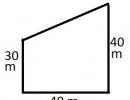Acetic acid interacts with the substance. Carboxylic acids - acetic, stearic. Physical properties of acetic acid
DEFINITION
Acetic acid(ethanoic acid, methanecarboxylic acid) is an organic substance with the formula. Weak, limiting monobasic carboxylic acid.
Chemical and structural formula of acetic acid
Chemical formula: CH3COOH
Gross formula: C2H4O2
Structural formula:

Molar mass: 60.05 g/mol.
Acetic acid is a saturated monobasic carboxylic acid. Forms acetates.
Weak acid, dissociation constant K a = 1.75 10 –5, pK a = 4.76.
Physical properties of acetic acid
Acetic acid is a colorless liquid with a sharp characteristic odor and sour taste. Hygroscopic, unlimitedly soluble in water. Exists in the form of dimers. Anhydrous acetic acid is called glacial acid because it forms an ice-like mass when it freezes.
Chemical properties of acetic acid
Acetic acid exhibits all the basic properties of carboxylic acids.
A qualitative reaction to acetic acid salts is interaction with strong acids. Acetic acid is weak and is displaced by strong acids from salt solutions, and its characteristic odor appears:
Receipt. The most cost-effective industrial method for producing acetic acid is the carbonylation of methanol with monoxide, the catalyst is rhodium salts, the promoter is iodide ions:
Biochemical method - ethanol oxidation:
Aqueous solutions of acetic acid are used in the food industry (food additive E260), household cooking, and canning. Acetic acid is used to obtain medicinal and fragrant substances, as a solvent.
Examples of problem solving
EXAMPLE 1
| Exercise | Calculate the pH of a solution of acetic acid with a molar concentration of 1 mol/l, the dissociation constant of which is 1.75 10 –5. |
| Solution | Let us write the dissociation equation for acetic acid: Acid dissociation constant:
Let us denote by x the concentration of hydrogen ions x = , then the expression for the dissociation constant will take the form:
Since acetic acid is weak, then x pH is the negative decimal logarithm of the equilibrium concentration of H + ions. Since x = , then |
| Answer | The pH of the solution is 2.38 |
EXAMPLE 2
| Exercise | Calculate the pH of the solution obtained by adding 5 ml of 0.1 M sodium hydroxide solution to 10 ml of 0.1 M acetic acid solution. Dissociation constant of acetic acid K a = 1.75 10 –5. |
| Solution | The total volume of the solution will be equal to: Ref ref ml When the solutions are drained, the following reaction occurs: Let's calculate the amounts of acetic acid and: Ex ref ref mole Ref ref According to the reaction equation, n(CH 3 COOH) = n(NaOH), and in our case n(CH 3 COOH) > n(NaOH), therefore, acetic acid is taken in excess. After the reaction occurs, the solution will contain acetic acid and sodium acetate, i.e. we got a buffer system. Let's calculate the concentration of sodium acetate in the resulting solution: |
1.) Acetic acid 1) has no double bonds in the molecule
2) used in the food industry 3) turns litmus red
4) does not form esters with alcohols 5) contains two carboxyl groups
2. For acetic acid, the following statements are true: 1) the composition of the molecule corresponds to the formula C 2 H 4 O 2) the carbon atoms in the molecule are connected by a double bond
3) has a specific odor 4) reacts with silver
5) reacts with copper(II) hydroxide
3. Indicate the statements that are true for acetic acid: 1) highly soluble in water
2) practically no smell 3) exhibits the properties of a strong acid
4) reacts with alkalis 5) under normal conditions is in a gaseous state
4. For acetic acid, the following statements are true: 1) refers to polybasic acids 2) all atoms in the molecule are connected by covalent bonds
3) poorly soluble in water 4) reacts with CO2 5) reacts with CaCO3
5. For acetic acid, the following statements are true: 1) the molecule contains 1 carbon atom 2) it is a hydrocarbon 3) the carbon atoms in the molecule are connected by a single bond 4) it reacts with copper(II) hydroxide 5) addition reactions with hydrogen chloride are characteristic
6. For acetic acid, the following statements are true: 1) the molecule contains two oxygen atoms 2) all atoms in the molecule are connected by single bonds
3) does not dissolve in water 4) reacts with copper 5) reacts with calcium carbonate
7. For acetic acid, the following statements are true: 1) the molecule contains 1 oxygen atom
2) is a highly soluble liquid in water (n.s.)
3) carbon atoms in the molecule are connected by a double bond
4) reacts with sodium carbonate 5) reacts with copper
8. The following statements are true for acetic acid: 1) changes the color of litmus
2) the molecule contains 3 oxygen atoms 3) reacts with alcohols
4) interacts with copper 5) burns to form hydrogen and carbon monoxide
9. For acetic acid, the following statements are true: 1) all bonds in the molecule are single
2) the molecule contains two carbon atoms 3) a water-insoluble liquid (n.s.)
4) reacts with Cu(OH)2 5) does not react with Na2CO3
10. Acetic acid is characterized by (a) 1) the presence of five hydrogen atoms in the molecule
2) good solubility in water 3) the presence of a double bond in the molecule
4) interaction with copper 5) interaction with hydrogen chloride
11. Indicate the statements that are true for acetic acid
1) at room temperature it is a liquid with a pungent odor
2) used in alcohol lamps as fuel
3) an aqueous solution conducts electric current
4) is a strong acid 5) the molecule contains only hydrogen and carbon
12. Indicate the statements that are true for acetic acid
1)at room temperature it is a solid
2) unlimited miscibility with water 3) is a strong acid
4) reacts with potassium carbonate 5) decolorizes bromine water
13. For acetic acid, the following statements are true: 1) the molecule contains one carbon atom 2) all atoms in the molecule are connected by single bonds 3) reacts with zinc 4) reacts with copper(II) oxide 5) does not react with CaCO3
14. Indicate the statements that are true for acetic acid: 1) all bonds in the molecule are single 2) the molecule contains two carbon atoms 3) is a liquid insoluble in water 4) reacts with active metals 5) does not react with sodium carbonate
Choose one correct answer. 1. Acetic acid cannot react with:
1. Acetic acid cannot react with:
1) potassium sulfate 3) ammonia
2) glycerin 4) phosphorus chloride (V)
2. Formic acid can be distinguished from other acids using:
1) solution of iron (III) chloride
2) ammonia solution of silver oxide (I)
3) litmus solution
4) bromine water
3. Dibasic saturated carboxylic acids include:
1) oxalic and valerian 3) propionic and amber
2) malonic and oil 4) amber and adipic
4. Limit higher fatty acid containing 16 carbon atoms:
1) palmitic 3) stearic
2) oleic 4) arachidonic
5. The product of decarboxylation of oxalic acid is:
1) butyric acid 3) acetic acid
2) propionic acid 4) formic acid
6. A substance that can react with both formic acid and
metanalem, has the formula:
1) NaOH 2) Cu(OH) 2 3) CH 4 4) HBr
7. Saturated carboxylic acids are:
1) croton and vinegar
2) propionic and palmitic
3) linoleic and oleic
4) stearic and arachidonic
8. Functional group – COOH is present in the molecule:
1) formaldehyde 3) acetic acid
2) ethyl acetate 4) phenol
1) CH 2 Cl – COOH 3) CH 2 I – COOH
2) CH 2 Br – COOH 4) CH 3 – COOH
10. Acetic acid interacts with:
1) sodium hydroxide and magnesium chloride
2) chlorine and water
3) sodium carbonate and magnesium
4) ethanol and ethanal
LIPIDS
Lipids are a large and diverse group of natural compounds, united by a common property - their practical insolubility in water and good solubility in organic solvents. Lipids, depending on their ability to hydrolyze, are divided into saponified and unsaponifiable.
Wax– esters of higher fatty acids and higher monohydric alcohols.
Palmitic acid cetyl ester (Spermaceti)
Palmitic acid myricyl ester (Beeswax)
Fats and oils(neutral fats) – glycerol esters of higher fatty acids. Triglycerides with limiting higher carboxylic acids (HCA), solid – fats; with unsaturated VKK, liquid – oils. If all three acids in the molecule are the same, it is a simple triglyceride; if they are different, it is a mixed triglyceride.




Ethanoic acid is better known as acetic acid. It is an organic compound with the formula CH 3 COOH. Belongs to the class of carboxylic acids, the molecules of which contain functional monovalent carboxyl groups COOH (either one or several). You can provide a lot of information about it, but now it’s worth noting only the most interesting facts.
Formula
You can see what it looks like from the image below. The chemical formula of acetic acid is simple. This is due to many things: the compound itself is monobasic, and it belongs to the carboxyl group, which is characterized by easy abstraction of protons (a stable elementary particle). This compound is a typical representative of carboxylic acids, since it has all their properties.
The bond between oxygen and hydrogen (−COOH) is highly polar. This causes an easy process of dissociation (dissolution, decay) of these compounds and the manifestation of their acidic properties.
As a result, the H + proton and the acetate ion CH3COO − are formed. What are these substances? An acetate ion is a ligand bound to a specific acceptor (an entity that receives something from a donor compound), forming stable acetate complexes with many metal cations. And a proton is, as mentioned above, a particle capable of capturing an electron with the electronic M-, K- or L-shells of an atom.
Qualitative analysis
It is based specifically on the dissociation of acetic acid. Qualitative analysis, also called reaction, is a set of physical and chemical methods that are used to detect compounds, radicals (independent molecules and atoms) and elements (collections of particles) that make up the substance being analyzed.
Using this method, it is possible to detect salts of acetic acid. It doesn't look as complicated as it might seem. A strong acid is added to the solution. sulfur, for example. And if the smell of acetic acid appears, then its salt is present in the solution. How it works? The residues of acetic acid, which are formed from the salt, at that moment bind with hydrogen cations from sulfuric acid. What is the result? The appearance of more molecules of acetic acid. This is how dissociation happens.
Reactions
It should be noted that the compound under discussion is capable of interacting with active metals. These include lithium, sodium, potassium, rubidium, francium, magnesium, cesium. The latter, by the way, is the most active. What happens during such reactions? Hydrogen is released, and the formation of the notorious acetates occurs. This is what the chemical formula of acetic acid looks like when it reacts with magnesium: Mg + 2CH 3 COOH → (CH 3 COO) 2 Mg + H 2.

There are methods for producing dichloroacetic (CHCl 2 COOH) and trichloroacetic (CCl 3 COOH) acids. In them, the hydrogen atoms of the methyl group are replaced by chlorine ones. There are only two ways to get them. One is the hydrolysis of trichlorethylene. And it is less common than the other, based on the ability of acetic acid to be chlorinated by the action of chlorine gas. This method is simpler and more effective.
This is what this process looks like in the form of the chemical formula of acetic acid reacting with chlorine: CH 3 COOH + Cl 2 → CH 2 CLCOOH + HCL. It’s just worth clarifying one point: this is how you get just chloroacetic acid, the two mentioned above are formed with the participation of red phosphorus in small quantities.
Other transformations
It is worth noting that acetic acid (CH3COOH) is capable of entering into all reactions that are characteristic of the notorious carboxylic group. It can be reduced to ethanol, a monohydric alcohol. To do this, it is necessary to treat it with lithium aluminum hydride, an inorganic compound that is a powerful reducing agent often used in organic synthesis. Its formula is Li(AlH 4).

Acetic acid can also be converted into acid chloride, an active acylating agent. This happens under the influence of thionyl chloride. By the way, it is an acid chloride of sulfurous acid. Its formula is H 2 SO 3. It is also worth noting that the sodium salt of acetic acid, when heated with an alkali, is decarboxylated (the carbon dioxide molecule is eliminated), resulting in the formation of methane (CH₄). And it, as you know, is the simplest hydrocarbon, which is lighter than air.
Crystallization
Glacial acetic acid - the compound in question is often called just that. The fact is that when it is cooled to just 15-16 °C, it goes into a crystalline state, as if it were freezing. Visually it really looks a lot like ice. If you have several ingredients, you can conduct an experiment, the result of which will be the conversion of acetic acid into glacial acid. It's simple. You need to prepare a cooling mixture from water and ice, and then lower a previously prepared test tube with acetic acid into it. After a few minutes it crystallizes. In addition to the connection, this requires a beaker, a stand, a thermometer and a test tube.
Harm of the substance
Acetic acid, the chemical formula and properties of which were listed above, is unsafe. Its vapors have an irritating effect on the mucous membranes of the upper respiratory tract. The threshold for the perception of the odor of this compound in the air is around 0.4 mg/l. But there is also the concept of maximum permissible concentration - a sanitary and hygienic standard approved by law. According to it, up to 0.06 mg/m³ of this substance can be in the air. And if we are talking about work premises, then the limit increases to 5 mg/m3.

The destructive effect of acid on biological tissue directly depends on how much it is diluted with water. The most dangerous solutions are those containing more than 30% of this substance. And if a person accidentally comes into contact with a concentrated compound, he will not be able to avoid chemical burns. This absolutely cannot be allowed, since after this coagulation necrosis begins to develop - the death of biological tissues. The lethal dose is only 20 ml.
Consequences
It is logical that the higher the concentration of acetic acid, the more harm it will cause if it gets on the skin or inside the body. Common symptoms of poisoning include:
- Acidosis. The acid-base balance shifts towards increasing acidity.
- Blood thickening and impaired clotting.
- Hemolysis of red blood cells, their destruction.
- Liver damage.
- Hemoglobinuria. Hemoglobin appears in the urine.
- Toxic burn shock.
Severity
It is customary to distinguish three:
- Easy. Characterized by minor burns of the esophagus and oral cavity. But there is no blood thickening, and the internal organs continue to function normally.
- Average. Intoxication, shock and blood thickening are observed. The stomach is affected.
- Heavy. The upper respiratory tract and the walls of the digestive tract are severely affected, and kidney failure develops. Maximum pain shock. The development of burn disease is possible.

Poisoning from acetic acid vapor is also possible. It is accompanied by a severe runny nose, cough and watery eyes.
Giving help
If a person is poisoned by acetic acid, it is very important to act quickly to minimize the consequences of what happened. Let's look at what needs to be done:
- Rinse your mouth. Do not swallow water.
- Perform tube gastric lavage. You will need 8-10 liters of cold water. Even blood impurities are not a contraindication. Because in the first hours of poisoning, large vessels still remain intact. So there will be no dangerous bleeding. Before washing, you need to give pain relief with analgesics. The probe is lubricated with Vaseline oil.
- Do not induce vomiting! The substance can be neutralized with burnt magnesia or Almagel.
- None of the above? Then the victim is given ice and sunflower oil - he needs to take a few sips.
- It is permissible for the victim to consume a mixture of milk and eggs.
It is important to provide first aid within two hours after the incident. After this period, the mucous membranes swell greatly, and it will be difficult to reduce a person’s pain. And yes, you should never use baking soda. The combination of acid and alkali will produce a reaction that produces carbon dioxide and water. And such a formation inside the stomach can lead to death.
Application
Aqueous solutions of ethanoic acid are widely used in the food industry. These are vinegars. To obtain them, the acid is diluted with water to obtain a 3-15 percent solution. As an additive they are designated E260. Vinegars are included in various sauces, and they are also used for canning food, marinating meat and fish. In everyday life, they are widely used for removing scale and stains from clothes and dishes. Vinegar is an excellent disinfectant. They can treat any surface. Sometimes it is added during washing to soften clothes.

Vinegar is also used in the production of aromatic substances, medicines, solvents, in the production of acetone and cellulose acetate, for example. Yes, and acetic acid is directly involved in dyeing and printing.
In addition, it is used as a reaction medium for the oxidation of a wide variety of organic substances. An example from industry is the oxidation of paraxylene (an aromatic hydrocarbon) by atmospheric oxygen into terephthalic aromatic acid. By the way, since the vapors of this substance have a sharp irritating odor, it can be used as a replacement for ammonia to bring a person out of fainting.
Synthetic acetic acid
This is a flammable liquid that belongs to substances of the third hazard class. It is used in industry. When working with it, personal protective equipment is used. This substance is stored under special conditions and only in a specific container. Typically this is:
- clean railway tanks;
- containers;
- tank trucks, barrels, stainless steel containers (capacity up to 275 dm 3);
- glass bottles;
- polyethylene barrels with a capacity of up to 50 dm 3;
- sealed stainless steel tanks.

If the liquid is stored in a polymer container, then this is for a maximum of a month. It is also strictly prohibited to store this substance together with such strong oxidizing agents as potassium permanganate, sulfuric and nitric acids.
Composition of vinegar
It’s also worth saying a few words about him. The composition of traditional, familiar vinegar includes the following acids:
- Apple. Formula: NOOCCH₂CH(OH)COOH. It is a common food additive (E296) of natural origin. Contained in unripe apples, raspberries, rowan, barberry and grapes. In tobacco and shag it is presented in the form of nicotine salts.
- Dairy. Formula: CH₃CH(OH)COOH. Formed during the breakdown of glucose. Food additive (E270), which is obtained by lactic acid fermentation.
- Ascorbic acid. Formula: C₆H₈O₆. Food additive (E300) used as an antioxidant that prevents product oxidation.
And of course, the ethane compound is also included in vinegar - this is the basis of this product.
How to dilute?
This is a frequently asked question. Everyone has seen 70% acetic acid on sale. It is bought to prepare mixtures for traditional treatment, or for use as a seasoning, marinade, additive to sauce or dressing. But you cannot use such a powerful concentrate. Therefore, the question arises of how to dilute acetic acid to vinegar. First you need to protect yourself - wear gloves. Then clean water should be prepared. For solutions of different concentrations, a certain amount of liquid will be required. Which? Well, look at the table below and dilute acetic acid based on the data.
Vinegar concentration | Initial concentration of vinegar 70% |
1:1.5 (ratio - one part vinegar to the nth part of water) |
|
In principle, nothing complicated. To get a 9% solution, you need to take the amount of water in milliliters according to this formula: multiply 100 grams of vinegar by the initial value (70%) and divide by 9. What do you get? The number is 778. 100 is subtracted from this, since 100 grams of acid were initially taken. This makes 668 milliliters of water. This amount is mixed with 100 g of vinegar. The result is a whole bottle of 9% solution.
Although, it can be done even simpler. Many people are interested in how to make vinegar from acetic acid. Easily! The main thing is to remember that for one part of a 70% solution you need to take 7 parts of water.
One of the first acids that became known to people in ancient times was acetic acid. This was discovered by accident - due to the appearance of vinegar during the souring of wine. In 1700, Stahl obtained a concentrated version of the chemical type of liquid, and in 1814, Berzelius established its exact composition.
Acetic acid can be produced in different ways, and it is used quite widely in many areas of economic activity.
Acetic acid is a synthetic product of the fermentation of carbohydrates and alcohols, as well as the natural souring of dry grape wines. Taking part in the metabolic process in the human body, this acid is a food additive used for the preparation of marinades and preservation.
Acid derivatives are vinegar - 3-9%, and vinegar essence - 70-80%. Esters and salts of acetic acid are called acetates. The composition of ordinary vinegar, to which every housewife is accustomed, includes ascorbic, lactic, malic, and acetic acids. Almost 5 million tons of acetic acid are produced annually in the world.
Transportation of acid over different distances is carried out in railway or road tanks made of specialized grades of stainless steel. In warehouse conditions, it is stored in sealed containers, containers, barrels under sheds or indoors. The substance can be poured and stored in a polymer container for one calendar month.
Qualitative characteristics of acetic acid
A colorless liquid with a sour taste and a pungent odor, which is acetic acid, has a number of specific advantages. Specific properties make the acid indispensable in many chemical compounds and household products.

Acetic acid, as one of the representatives of carboxylic acids, has the ability to exhibit high reactivity. By reacting with a variety of substances, the acid becomes an initiator of compounds with functional derivatives. Thanks to such reactions, it becomes possible:
- Formation of salts;
- Amide formation;
- Formation of esters.
Acetic acid has a number of specific technical requirements. The liquid must be soluble in water, free from mechanical impurities and have established proportions of quality components.
Main applications of acetic acid E-260
The variety of areas in which acetic acid is applicable is quite large. This acid is an essential component of many medications - for example, phenacetin, aspirin and other varieties. Aromatic amines of the NH2 group are protected during nitration by introducing the acetyl group CH3CO - this is also one of the most common reactions in which acetic acid enters.
The substance plays a rather important role in the production of cellulose acetate, acetone, and various synthetic dyes. The production of various perfumes and non-flammable films cannot be done without her participation.

Acetic acid is often used in the food industry as a food additive E-260. Canning and household cooking are also successful fields of action and use of high-quality natural additives.
When dyeing, the main types of acetic acid salts play the role of special mordants, ensuring a stable connection of textile fibers with the dye. These salts are often used to control the most persistent varieties of plant pests.
Precautions when working with acetic acid
Acetic acid is considered a flammable liquid, which is assigned the third hazard class - in accordance with the classification of substances according to the degree of hazardous effects on the body. When working with this type of acid, specialists use individual modern protective equipment (filter gas masks).

Even the food additive E-260 can be toxic to the human body, but the degree of exposure will depend on the quality of dilution of concentrated acetic acid with water. Solutions in which the acid concentration exceeds 30% are considered life-threatening. In contact with the skin and mucous membranes, high concentration acetic acid will cause severe chemical burns.
At the same time, the method of obtaining the acid does not play a special role in its toxicological nature, and a dose of 20 ml can be lethal. Various consequences can be detrimental to many human organs - from the oral mucosa and respiratory tract to the stomach and esophagus.
If acid inadvertently gets inside, it is important to drink as much fluid as possible before doctors arrive, but under no circumstances induce vomiting. Repeated passage of substances through the body can re-burn organs. In the future, gastric lavage with a tube and hospitalization will be necessary.






